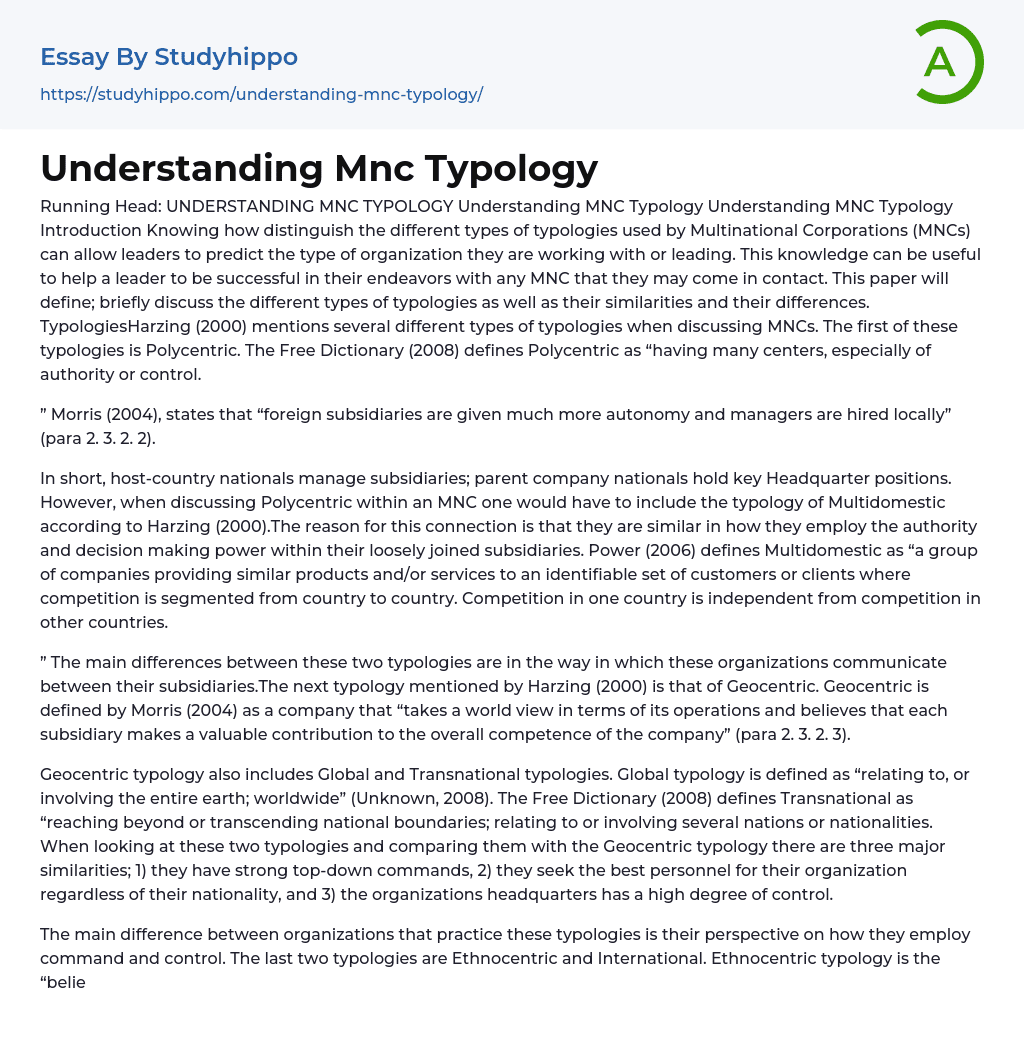Introduction
Knowing how to distinguish the different types of typologies used by Multinational Corporations (MNCs) can allow leaders to predict the type of organization they are working with or leading. This knowledge can be useful to help a leader to be successful in their endeavors with any MNC that whom they may come in contact with. This paper will define; briefly discuss the different types of typologies as well as their similarities and their differences.
Typologies
Harzing (2000) mentions several different types of typologies when discussing MNCs. The first of these typologies is Polycentric. The Free Dictionary (2008) defines Polycentric as “having many centers, especially of authority or control.
” Morris (2004), states that “foreign subsidiaries are given much more autonomy and managers are hired locally” (para 2. 3. 2. 2).
In short, host-country nationals manage subsidiaries; parent company
...nationals hold key Headquarter positions. However, when discussing Polycentric within an MNC one would have to include the typology of Multi domestic according to Harzing (2000). The reason for this connection is that they are similar in how they employ authority and decision-making power within their loosely joined subsidiaries. Power (2006) defines Multidomestic as “a group of companies providing similar products and/or services to an identifiable set of customers or clients where competition is segmented from country to country. Competition in one country is independent of competition in other countries.
” The main differences between these two typologies are in the way in which these organizations communicate between their subsidiaries.The next typology mentioned by Harzing (2000) is that of Geocentric. Geocentric is defined by Morris (2004) as a company that “takes a world view in terms of its operations and believes that
each subsidiary makes a valuable contribution to the overall competence of the company” (para 2. 3. 2. 3).
Geocentric typology also includes Global and Transnational typologies. Global typology is defined as “relating to, or involving the entire earth; worldwide” (Unknown, 2008). The Free Dictionary (2008) defines Transnational as “reaching beyond or transcending national boundaries; relating to or involving several nations or nationalities. When looking at these two typologies and comparing them with the Geocentric typology there are three major similarities;
- they have strong top-down commands,
- they seek the best personnel for their organization regardless of their nationality, and
- the organizations' headquarters has a high degree of control.
The main difference between organizations that practice these typologies is their perspective on how they employ command and control. The last two typologies are Ethnocentric and International. Ethnocentric typology is the “belief in the superiority of one's own ethnic group” (Unknown, 2008).An organization such as this believes that their key management positions “in both the HQ and subsidiaries” should be filled by Parent-Country Nationals that live locally or within their nation (Morris, 2004, para 2. 3.
Organizations that participate in Ethnocentric typologies are most commonly found in an International organizations.
Conclusion
When discussing MNCs it is this student’s opinion that these typologies are interconnected to some degree. However, these MNCs do provide a fairly clear identification of which MNC is operating based on their typology.
Understanding these typologies will allow a leader to distinguish the differences of an MNC before they make a move to lead an organization such as this and will give them the tools needed to make valued assessments so they can better lead any of these organizations to success.
References
- Power,
P. (2006). Multidomestic Industry. Retrieved September 7, 2008, from Planning Skills Web site: http://planningskills. com/glossary/54. php Morris, K. (2004).
- African American essays
- African American Culture essays
- American Values essays
- Asian American essays
- Chinese essays
- Ethnicity essays
- Ethnocentrism essays
- German essays
- Han Chinese essays
- Hispanic essays
- Identity essays
- Korean essays
- Mexican essays
- Nation essays
- Native American essays
- Race and Ethnicity essays
- White People essays
- Accounting essays
- Andrew Carnegie essays
- Automation essays
- Business Cycle essays
- Business Intelligence essays
- Business Model essays
- Business Operations essays
- Business Software essays
- Cooperation essays
- Cooperative essays
- Corporate Social Responsibility essays
- Corporation essays
- Customer Relationship Management essays
- Family Business essays
- Franchising essays
- Harvard Business School essays
- Harvard university essays
- Human Resource Management essays
- Infrastructure essays
- Inventory essays
- Logistics essays
- Management essays
- Manufacturing essays
- Market essays
- Marketing essays
- Multinational Corporation essays
- News Media essays
- Online Shopping essays
- Quality Assurance essays
- Richard Branson essays
- Sales essays
- Selling essays
- Shopping Mall essays




